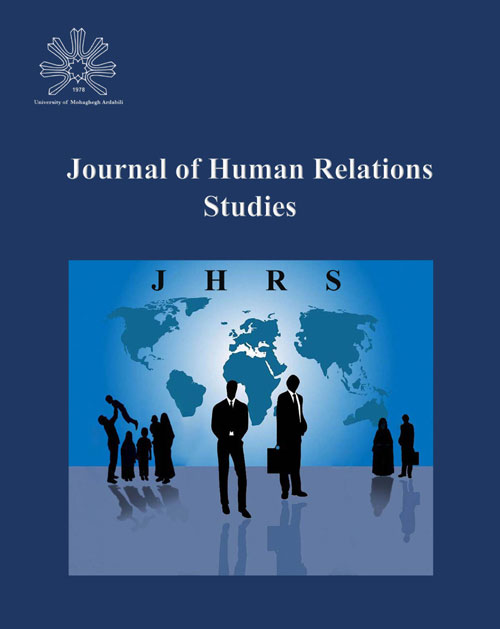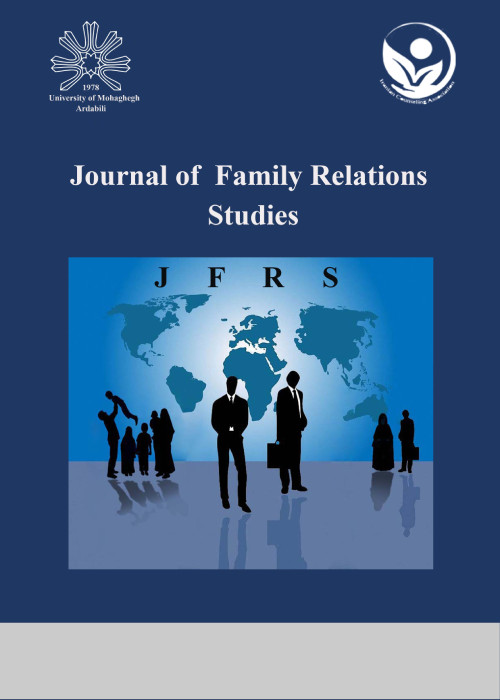فهرست مطالب

Journal of Family Relations Studies
Volume:2 Issue: 5, Jun 2022
- تاریخ انتشار: 1401/03/18
- تعداد عناوین: 6
-
-
Pages 4-14
The aim of this research design and validation of youth high-risk behaviors short scale. In this research, descriptive-survey method was used. The statistical population was all students of Mashhad universities which 681 students were randomly (Lottery) selected from multi-stage cluster type. The tools used also included: youth high-risk behaviors short scale developed by researcher, which has seven components: tendency to drug, alcohol, smoking, violence, self-harm, dangerous sex, and dangerous driving. This scale has a five-point Likert scale and is scored from strongly disagree = 0 to strongly agree = 4, as well as the Big Five-Inventory (2007) and Psychological Well-being Scale (1989). The results showed that the 14-item high-risk behaviors scale has good psychometric properties and is norm with Iranian society. The validity of the scale was good with the methods of construct validity (confirmatory factor analysis) and convergent and divergent validity (p<0.01). The Results of confirmatory factor analysis also confirmed the seven-factor nature of the scale and the obtained model had a good fit with the research data. The Cronbach's alpha coefficient of the whole scale was 0.82. Therefore, due to the unique features, researchers and health professionals can use this tool in their future studies.
Keywords: high risk behaviors, Short Version, validation, factor analysis -
Pages 15-22
The aim of this study was to investigate the relationship between action flexibility and personality traits with marital adjustment of married students. The present study was a descriptive correlational study. In this study, 400 married students of Shahrood Azad University in the2020-2021 academic year were selected by convenience sampling method and action flexibility questionnaire, personality traits questionnaire and marital adjustment questionnaire were used to collect data. Data was analyzed simultaneously using SPSS software version 21, the statistical method of Pearson correlation coefficient and multiple regression. Findings showed that there was a significant relationship between action flexibility and marital adjustment. There was also a significant correlation between the components of extraversion, agreeableness and openness to experience with marital adjustment; but there was no significant correlation between the components of honesty-humility, emotionality and conscientiousness with marital adjustment. Action flexibility allows the individuals to adjust themselves well to the life traumatic events, and successfully demonstrate positive adjustment to traumatic events, which can be related to marital adjustment and lead to it. Personality traits cause individuals to react differently to life issues and problems. The more people are able to control stress, the less they use emotion- focused coping techniques that lead to maladjustment.
Keywords: Action flexibility, personality traits, marital adjustment, Married students -
Pages 23-30Background and purpose
This study was conducted to investigate the relationship between attachment styles and aggression with individual-social adjustment in married women referred to family counseling centers in Hamadan.Cases and
MethodsThe survey research method was correlational and its statistical population included all married women referring to family counseling centers in Hamadan. They were selected by simple random sampling. Data collection tools were the Collins and Read Attachment Styles Questionnaire (1990), Buss & Perry Aggression Questionnaire (1992) and the California Socio-Individual Adjustment Scale (CPI).
ResultsThe results showed that among attachment styles, only between secure attachment style with increasing individual-social adjustment of married women There is a positive and significant relationship and there is a significant and negative relationship between aggression and increasing individual-social adjustment of married women.
ConclusionIt can be concluded that Among the attachment styles, there is only a positive and significant relationship between secure attachment style with increasing the individual-social adjustment of married women under study Also, there is a negative and significant relationship between aggression and social adjustment. In general, the results have shown that the attachment styles and aggression of married women a large extent determine their individual and social adjustment.
Keywords: Attachment styles, Aggression, Individual-Social Adjustment, Married Women -
Pages 31-40Objective
The aim of this study was to investigate the mediatory role of spiritual well-being in relationship attachment styles and adaptive problem-solving styles.
MethodThe research method was the correlation of the type structural equation modeling. The population included all Undergraduate students Poldokhtar Higher Education Center who were studying in the academic year 2020-2021. 230 students participated in this study online and respond to Problem Solving Style (PSS), Adult Attachment Scale (AAS), and Spiritual Well-Being Scale (SWBS). Data analysis was performed using the Path analysis statistical method and by the SPSS-22, and AMOS-24 software.
ResultsThe results showed that secure and avoidant attachment indirectly mediate the students' adaptive problem-solving styles by mediating spiritual well-being; ambivalent attachment does not, directly and indirectly, affect students' adaptive problem-solving styles. Secure and avoidant attachments directly affect spiritual well-being. Spiritual well-being also has a direct effect on adaptive problem-solving.
ConclusionOverall, the results of this study showed that spiritual well-being mediates the relationship between secure attachment style and avoidance with adaptive problem-solving styles. The findings of this study emphasize the role of the relationship between caregivers and the child in the formation of spiritual well-being and adaptive problem-solving styles.
Keywords: Attachment styles, spiritual well-being, Problem-Solving Style -
Pages 41-48Objective
This study aimed to compare the theory of mind (ToM), planning and organization, perceived parenting style, and hyperactivity symptoms in 7-12-year-old children with employed mothers and housewives in Isfahan.
MethodsThe statistical population of the present study included all children in Isfahan in the second half of 2020. Of these, 60 subjects were selected by the available sampling method. Data were collected by the Steernman Mind Theory Questionnaire, Coolidge Executive Functions, the Bamrind Parenting Style, and Attention Deficit Hyperactivity Disorder and analyzed by the Manova method.
ResultsThe results showed that there were significant differences between the scores of children with employed mothers and those with housewife mothers in the scales of ToM, planning and organization, parenting style, and hyperactivity symptoms (P < 0.05). It was revealed that differences in terms of parenting styles and relationships between children and parents could explain such differences.
ConclusionIt is suggested to address the parenting styles and relationships between children and parents to help with the reduction of the rate of hyperactivity symptoms.
Keywords: Mind Theory, Planning, Parenting style, Hyperactivity Symptoms -
Pages 49-56
The aim of this study was to compare the life satisfaction and hoping in mothers of children with special learning disabilities, autism spectrum disorders, and normal. The present research method was causal-comparative. The statistical population of was mothers of fifth and sixth-grade children in the north of Tehran, whose children, according to expert diagnosis, had a special learning disability and autism spectrum disorder, and mothers were selected from a normal group too. Finally, the sample of 90 people (30 people in each group) was selected by non-probabilistic and purposeful sampling method. The tools used were Snyder's Hoping Scale and Huebner's Life Satisfaction Multidimensional Scale. The results showed that the mean score of mothers with autistic children was lower than that of mothers with disability and normal children (p<0.01), and the mean life satisfaction score of mothers with normal children was higher than that of mothers with autism children (p<0.01). Also, the mean score of hoping and life satisfaction of mothers with specific learning disability children was more than mothers with autism children (p<0.01). The relatively low level of hoping and life satisfaction the mothers of children with autism spectrum, more attention and arrangements is very important for their psycho-social empowerment.
Keywords: mothers, Autism spectrum Disorder, special learning disabilities, hoping, life satisfaction


